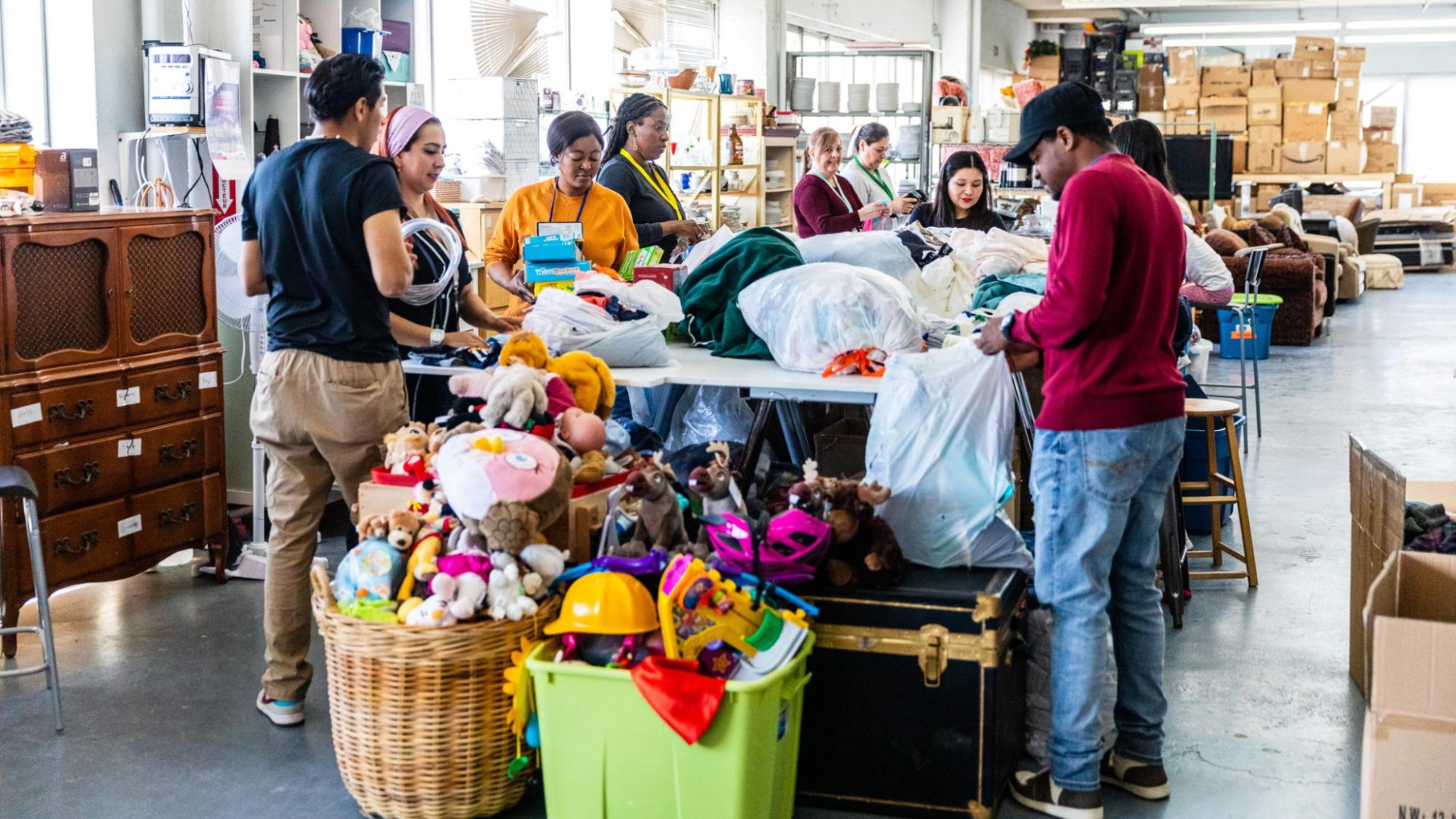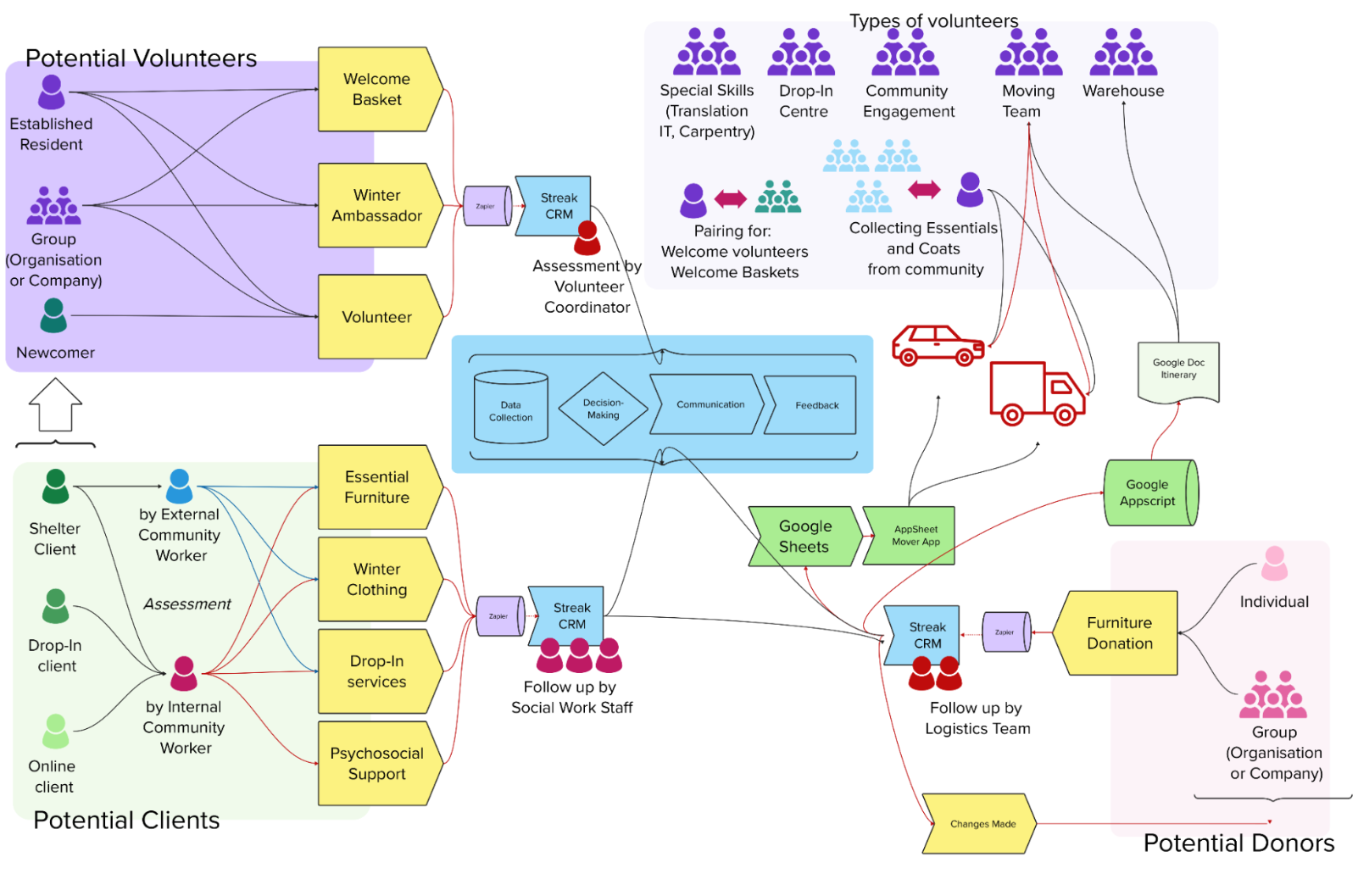How a small charity used forms and data to help 10,000 refugee claimants
Why It Matters
Collecting and integrating data from various sources into a CRM system can help an organization measure real-time community impact.

A small Montreal charity was able to help 10,000 refugees and newcomers in 2023 thanks to a series of forms and data flows they designed to crunch the information more effectively.
“There was a bunch of data that was interesting: where people were coming from; when they arrived; the makeup of a family and pregnancies,” said Rani Cruz, director of development and impact for Welcome Collective.
Welcome Collective / Collectif Bienvenue started when a group of friends came together as volunteers and has since grown into a staff of 16 people and a volunteer workforce.
The organization works with refugee claimants in Montreal to help them build a new life in the city, supplying them with secondhand furniture, household items and clothing and connecting them to psychosocial support.
Now, more than six years since the charity’s inception, the data is collected using a series of forms for refugee claimants, staff, and volunteers and fed into a customer relationship management (CRM) system.
The CRM then allows for automated notifications to various teams within the organization, who use this information to provide a refugee claimant or family the appropriate support.
When a social worker sees a refugee claimant with immediate needs, they can use Welcome Collective’s forms and CRM system to trigger the logistics team to make the appropriate deliveries. Equally, when an individual or an external organization makes a furniture donation, the logistics team can automatically access their information for pickup and to generate tax receipts.
Using postal code information, Cruz can also pull out information about the neighbourhoods where most refugee claimants live, observe changes year-over-year, and use that information to partner with organizations providing support on a hyperlocal level, such as food banks.
“When we first started, we were collecting data on basic material needs, like what we were giving out. Now, we’re keeping track of all kinds of support we give and what people come to Welcome Collective for,” Cruz said.
“Did they need help filling in the [Canadian Refugee Protection] Portal? Or registering their kids for school?”
How did Welcome Collective build this data-driven system?

Welcome Collective gathers all of its data using various forms for different stakeholders. On the flowchart above, each form is indicated by a yellow shape.
There are forms for clients who come into the centre, for social workers to request items and services on behalf of clients, for the volunteer coordinator to keep track of volunteers, and for furniture donors to provide information about the items they want to give.
Cruz constantly updates the forms as the organization develops new metrics to track.
For instance, since a major border crossing between the U.S. and Quebec closed in early 2023, there has been an increase in inland refugee claims – in other words, a claim made for refugee status once an individual or family has already entered Canada. This became a new metric that Welcome Collective started to track.
As the amount of data increased and the integrations between the forms became more complex, Cruz also realized the data needed to be in real-time and searchable, changing how specific numbers were tracked.
For example, instead of asking for children’s ages, they began asking for birth years so that the system could track their ages as the children grew up.
There is only value in collecting this data if confidentiality and privacy are respected – especially when handling the information of an already vulnerable group of people, she added.
“We separate the person’s personal information from the reasons we have seen them,” she said. “We don’t ask people for their stories or why they’ve left their countries. That is none of our business, and it’s a story they will have to tell their lawyer or judge. Most of the time, it is traumatic, and we don’t want clients to feel like we’re invading their privacy.”
How have staff and frontline workers taken to the data-centric approach?
“Social workers do a lot more than they used to do 20 years ago,” Cruz said, so it is not unnatural for them to resist change. Designing a user experience that didn’t add to their workload would be crucial to making data and automation a central part of the organization.
Social workers don’t necessarily need to see the ins and outs of the CRM system, but they need to understand the value of inputting data into the system, Cruz said.
One clear use case is that the CRM system automates the process by which a social worker typically makes referrals to other teams. Nobody will fall through the cracks because a social worker forgets or makes a mistake – the system “forces them to tell the team” what each person or family needs.
Because the data is also connected to the inventory of supplies that Welcome Collective can give, social workers can also use it to decide where these limited resources should be allocated.
When developing these workflows, Cruz spent time with frontline workers and observed how they work.
“I’ve physically watched social workers work, seen how they greet a family when they arrive, and at what point they start filling in forms.”
After these observations, Cruz changed the process flow that allowed clients to fill in some information while waiting to be seen by a social worker. That meant that the social worker didn’t have to deal with the mandatory parts of the form, such as personal information.
They could be present to listen to the client and then fill in the remainder of the information once the client has left.
What technology does the charity use to connect data inputs to the correct outputs?
Cruz started building the system on Google Sheets and Google Forms and found that she quickly hit the limit of free usage. Since then, she has been experimenting with several different form builders, eventually settling on Cognito Forms.
Not only is it easy to use and affordable, but it is also flexible in allowing for conditional questioning, she said. This means those filling in the forms can be led down a particular path depending on their responses and needs.
All the data from the various forms is then integrated using Zapier and fed into Welcome Collective’s centralized CRM system, called Streak.
Streak allows the team to control who can access confidential or sensitive personal information.
Finally, the logistics team uses a Google Sheets template to calculate pickup fees and charitable tax receipts for the pickups and drop-offs of used furniture and household items.
This information is then fed into Appsheet, which creates a simple itinerary for pickups and drop-offs on any given day.
Specific tools and software solutions are either heavily discounted or free for charities. At Welcome Collective, the technology budget for next year is $6,200, which is similar to the budget for the previous year.
“We have a small budget, and I’d rather spend the money on winter coats than software,” Cruz said.
Can other non-profits build similar systems?
Cruz and the Welcome Collective draw on the data in various contexts: it is used in the annual report and to provide critical statistics to funders, such as the number of people they’ve served, the number of people needing particular kinds of support, how many donors the organization has, and how many furniture deliveries have been made.
Cruz also hopes that sharing the features of Welcome Collective’s data flow will emphasize the need for more standardized data collection between settlement organizations.
Cruz manages the system as a team of one. Over two weeks, she worked exclusively on this data-driven approach to the charity’s processes, observing how staff and volunteers worked, learning how to code, and testing different software solutions.
These two weeks allowed her to tap into her creativity, but she also recognizes that this isn’t a privilege every non-profit can afford.
ChatGPT has also allowed Cruz to speed up her code and algorithms.
While she’s considering hiring somebody to help, she also notes that a blend of hard and soft skills is required to do this work, which is difficult to come by.
“You need to know how to code or be comfortable enough to learn,” she said, “but you also have to be adaptable with your team. Finding people who will have that patience is hard.”

